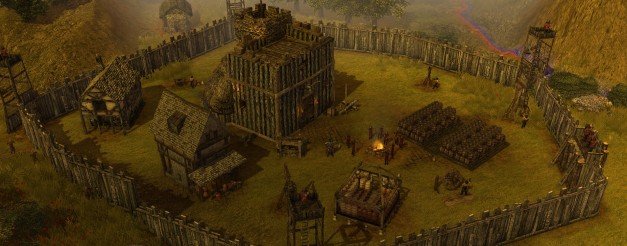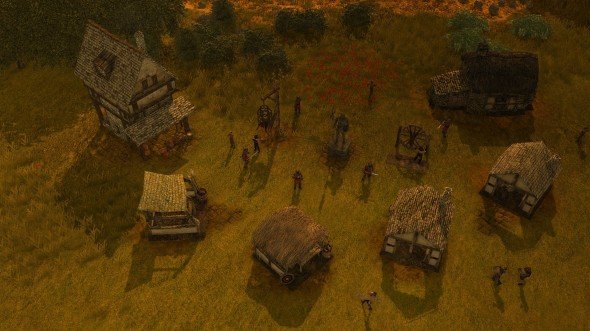Stronghold 3 preview

Firefly admit they over-complicated Stronghold 2 a little. Let's say you had a carpenter and all he did in Stronghold 1 was go back and forth between trees and his shack. In Stronghold 2, he had a chance of going bad and becoming an anti-carpenter.
He'd steal food from the castle and whinge about getting splinters. Then you had to construct a chain of a buildings to capture him, imprison him, torture him, try him, tar and feather him, and eventually reform him; all to make it so that you could get some wood. Rather than the tried and tested old-fashioned system of lopping his head off and recruiting a new carpenter.
Thankfully, they've realised the error of their ways and moved back to the old Stronghold model of simple castle-building fun. They've also moved to the Trinigy Vision engine of their competitors, The Settlers, bringing to it freeform castle design. You can drag castle walls into all sorts of shapes, drop in buttresses, towers, gateways and the like, then watch the walls morph like granite blancmange to accommodate them. Similarly, houses dynamically shift their appearance the further from the citadel they get, changing from singleperson shacks a mile outside the walls to whopping great burgher mansions nestled against the inner fort itself.

Aside from building them, Firefly are proud of how their castles and people fall apart when big rocks hit them, thanks to a new physics engine. We were shown a demo of what trebuchets do to castles (hint: they don't wine them and dine them). The Havok physics were deliberately overblown: soldiers tumbled off the walls, individual stones were blasted away, and entire chunks of the structure were rendered indefensible – yet still impassable.
The newly-revealed combat system was much as you'd expect: peasants died quickly, foot knights hacked at each other, archers picked them off from afar. Yet other elements had that inspirational (and very British) sadism of Rome: Total War's flaming pigs. Whether it was the burning logs rolled from a castle's walls, cages of rabid hounds waiting to be unleashed on the enemy, or giant palisades of wooden spikes filtering knights into killing fields, Firefly really showed a nicely grim sense of humour. Similarly, in-game events that can affect your castle's economy range, from mad cow disease to your woodcutters refusing to work because they're scared of fairies.
For cow-catapult fans, we have more details on their ammo: they can actually fling a variety of infected animals into castles. You can choose a single cow (“...and your father smells of elderberries!”), two pigs, three sheep, or a bag of disgruntled badgers. These catapults spread disease rather than causing physical damage, and the animal type determines how many and how large the miasma clouds are that are left. Disease kills troops but leaves the buildings standing, and requires a new specialist, the apothecary, to remove it.

This new engine also introduces fog-of- war in the form of night battles. While it never made sense in daytime (“we're in a giant castle on top of a hill, don't you think we know what you're doing down there behind that hedge?”) it does with the new day-night cycle. At night, only areas lit up by such new, special constructions as watchfires and beacons are visible to your troops, and your troops need to maintain them. This makes a surprise night assault – like that carried out by The Wolf in the first story mission – not only plausible and strategically sound, but pretty awesome to watch when lit by several hundred individual torches.
Keep up to date with the most important stories and the best deals, as picked by the PC Gamer team.
Yes, The Wolf has returned. In the first game, four lords usurped the kingdom and your goal was to restore the rightful king; it seems the singleplayer plot this time will focus on the revenge of The Wolf, the nastiest of the four, who has somehow recovered from being chopped up and thrown from the walls. He'll return in the bloodier of the two singleplayer campaigns, while the other focuses on building castles and economies for the SimCity fan in all of us. This will be told through a dark comicbook style in between missions.
On top of that there's a huge variety of multiplayer modes, administered through Steam, and players can also use the map editor to create and share castles – though lead designer Simon Bradbury is aware that they need “some kind of filtering system to avoid hundreds of castles looking like penises.” The team are even talking of letting you place your castles on an integrated Google map, and see how you've done in the campaign /multiplayer in your local area. At the moment, the only style of castle available is the classic Edward I – other architectural styles might be DLC later on, if there's a demand. I think there will be.

